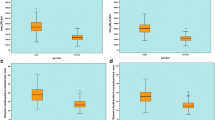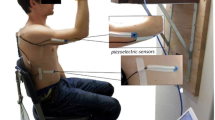Abstract
Although explosive isometric contraction provides little work toward the outside, force-time parameters of the rising phase of the force-time curve may be able to predict muscle power. The purpose of this study was to examine the relationship between muscle power with work (power grip) and force-time parameters during the rising phase in explosive isometric grip. Fifteen healthy young adult males participated in this study. Power grip was measured using loads of 20%–50% of maximal voluntary contraction (MVC) (peak isometric force). Subjects pulled explosively on a grip bar held with the second digital joints without the thumb. Peak power was calculated from peak velocity and load. Explosive isometric grip was measured using a hand dynamometer. Time-series data of both tests were sampled by an analog-to-digital interface. Both tests were performed with the subjects seated with a sagittal and horizontal position of the arm supported by an armrest. Peak power in the power grip test tended to be larger with an increase of the load, but there was no significant difference between 40% and 50% MVC. Only the peak power in 50% MVC significantly correlated with peak grip force (r=0.52, p<0.05). The force-time parameters related to the peak rate of the rising force phase in explosive isometric grip significantly correlated with the peak powers (30%–50% MVC, r=|0.58−0.78|). Peak rate of the rising force phase in explosive isometric grip may be useful for predicting muscle power with loads between 30%–50% MVC.
Similar content being viewed by others
References
Davies CT, Sandstrom ER (1989) Maximal mechanical power output and capacity of cyclists and young adults. Eur J Appl Physiol Occup Physiol 58:838–844
Thompson CJ, Bemben MG (1999) Reliability and comparability of the accelerometer as a measure of muscular power. Med Sci Sports Exerc 31:897–902
Yoshimura Y, Demura S, Yamaji S et al (2001) Examining force-exertion patterns based on force-time relationships in the development phase during static explosive grip. Jpn Soc Edu Health Sci 47:194–201
Demura S, Yamaji S, Minami M et al (1999) Examining reproducibility of force-exertion pattern and reliability of force-time parameters in the development phase during static explosive grip exertion. Jpn Soc Phys Fitness Sports Med 48:493–500
Demura S, Yamaji S, Nagasawa Y et al (2003) Reliability and gender differences of static explosive grip parameters based on force-time curves. J Sports Med Phys Fitness 43:28–35
Bemben MG, Clasey JL, Massey BH (1990) The effect of the rate of muscle contraction on the force-time curve parameters of male and female subjects. Res Q Exerc Sport 61:96–99
Bemben MG, Massey BH, Bemben DA et al (1991) Isometric muscle force production as a function of age in healthy 20-to 74-yr-old men. Med Sci Sports Exerc 23:1302–1310
Chengalur SN, Smith GA, Nelson RC, Sadoff AM (1990) Assessing sincerity of effort in maximal grip strength tests. Am J Phys Med Rehabil 69:148–153
Demura S, Yamaji S, Nagasawa Y, Masaki M (2000) Examination of force-production properties during static explosive grip based on force-time curve parameters Percept Mot Skills 91:1209–1220
Gilbert JC, Knowlton RG (1983) Simple method to determine sincerity of effort during a maximal isometric test of grip strength. Am J Phys Med 62:135–144
Hakkinen K, Komi PV, Alen M (1985) Effect of explosive type strength training on isometric force-and relaxation-time, electromyographic and muscle fibre characteristics of leg extensor muscles. Acta Physiol Scand 125:587–600
Hakkinen K, Alen M, Komi PV (1985) Changes in isometric force-and relaxation-time, electromyographic and muscle fibre characteristics of human skeletal muscle during strength training and detraining. Acta Physiol Scand 125:573–585
Smith GA, Nelson RC, Sadoff SJ, Sadoff AM (1989) Assessing sincerity of effort in maximal grip strength tests. Am J Phys Med Rehabil 68:73–80
Walamies M, Turjanmaa V (1993) Assessment of the reproducibility of strength and endurance handgrip parameters using a digital analyser. Eur J Appl Physiol Occup Physiol 67:83–86
Demura S, Yamaji S, Nagasawa Y, Ikemoto Y, Shimada S (2001) Force developmental phase and reliability in explosive and voluntary grip exertions. Percept Mot Skills 92:1009–1021
Ikemoto Y, Demura S, Yamaji S et al (2006) The characteristics of simple muscle power by gripping: gender differences and reliability of parameters using various loads. J Sports Med Phys Fitness 46:62–70
Laboratory of Physical Education. Tokyo Metropolitan University (2000) New physical fitness standards of Japanese people, 5th edn. Fumaido, Tokyo, pp 98–101
Oldfield RC (1971) The assessment and analysis of handedness: the Edinburgh inventory. Neuropsychologia 9:97–113
Suzuki M, Yamazaki Y, Matsunami K (1994) Relationship between force and electromyographic activity during rapid isometric contraction in power grip. Electroencephalogr Clin Neurophysiol 93:218–224
Ikemoto Y, Demura S, Yamaji S (2004) Relations between the inflection point on the force-time curve and force-time parameters during static explosive grip. Percept Mot Skills 98:507–518
Baker D, Wilson G, Carlyon B (1994) Generality versus specificity: a comparison of dynamic and isometric measurements of strength and speed-strength. Eur J Appl Physiol 68:350–355
Gravel D, Richards C, Filion M (1988) Influence of contractile tension development on dynamic strength measurements of the planter flexors in man. J Biomechanics 21:89–96
Author information
Authors and Affiliations
Corresponding author
Rights and permissions
About this article
Cite this article
Ikemoto, Y., Demura, S., Yamaji, S. et al. Force-time parameters during explosive isometric grip correlate with muscle power. Sport Sci Health 2, 64–70 (2007). https://doi.org/10.1007/s11332-007-0041-3
Received:
Accepted:
Published:
Issue Date:
DOI: https://doi.org/10.1007/s11332-007-0041-3




